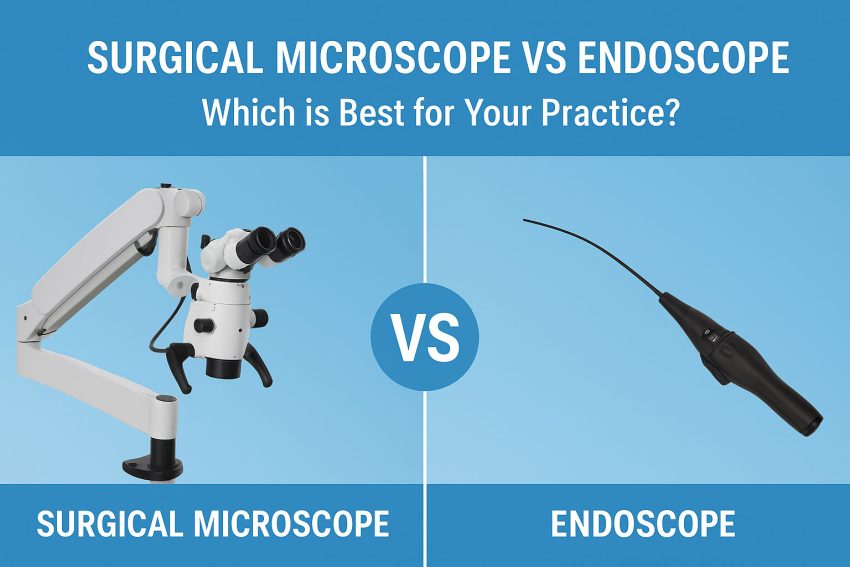When it comes to precise surgical visualization, two tools dominate the market: surgical microscopes and endoscopes. Both technologies enhance a surgeon’s ability to perform minimally invasive procedures, but they serve different purposes and excel in different types of surgeries.
In this article, we’ll compare surgical microscopes and endoscopes across several key factors—such as functionality, specialty use, advantages, and limitations—to help you determine which is best for your practice.
🧠 Surgical Microscope: Overview and Features
A surgical microscope is a high-precision optical device used to magnify the surgical field for detailed visualization. Surgical microscopes are commonly used in specialties like neurosurgery, ophthalmology, ENT, and dental procedures.
✅ Key Features:
- Magnification: Offers variable magnification levels (up to 40x or more) for extremely detailed views of small tissues, vessels, or nerves.
- Lighting: Coaxial lighting ensures uniform illumination and minimal shadowing, which is vital for deep cavity surgeries.
- Ergonomics: Adjustable mounts, headrests, and foot controls allow surgeons to maintain a comfortable position during long procedures.
- Image Capture: Many modern microscopes come with built-in cameras for recording and real-time sharing with students or colleagues.
Best for: High-precision surgeries such as neurosurgery, ophthalmology, dental, and ENT surgeries.
🔎 Endoscope: Overview and Features
An endoscope is a flexible or rigid tube with a camera at the tip, used for viewing internal structures during minimally invasive surgery. Unlike surgical microscopes, which provide direct, high-magnification views, endoscopes allow surgeons to navigate and visualize body cavities using a camera display.
✅ Key Features:
- Flexibility: Endoscopes can be rigid or flexible, with the flexible models used for navigating difficult-to-reach body areas.
- Camera Integration: High-definition cameras at the end of the endoscope allow for real-time visualization on a monitor, offering excellent flexibility.
- Portability: Endoscopes are more compact and lightweight, making them easier to use in a variety of surgical settings.
- Illumination: LED lighting at the tip provides bright, clear images of internal structures.
Best for: Minimally invasive surgeries like laparoscopic, gastrointestinal, and urological procedures.
📊 Surgical Microscope vs Endoscope: A Direct Comparison
| Feature | Surgical Microscope | Endoscope |
|---|---|---|
| Purpose | Magnification for high-precision surgical tasks | Internal visualization via a camera and flexible tube |
| Magnification | Up to 40x or more, high resolution | Fixed magnification, typically lower resolution |
| Lighting | Coaxial lighting for uniform illumination | LED at the tip of the endoscope |
| Application | Neurosurgery, ophthalmology, ENT, dental | Laparoscopy, gastrointestinal, urology, minimal access surgery |
| Flexibility | Stationary, mounted on a stand | Flexible (or rigid) tube for navigation |
| Image Capture | Built-in camera and live imaging | External monitor display, sometimes with video recording |
| Cost | Higher (due to complex optics and features) | More affordable, with basic models being less expensive |
| Space Requirements | Requires significant space and mounting | Compact and portable, easy to move between rooms |
🩺 Which is Best for Your Practice?
When deciding between a surgical microscope and an endoscope, consider your practice’s primary specialties and surgical needs:
- Neurosurgeons: Surgical microscopes offer exceptional magnification and stability, making them ideal for delicate, high-precision tasks.
- Ophthalmologists: Microscopes are essential for detailed eye surgeries such as cataract removal and retinal repair.
- ENT Specialists: Both microscopes and endoscopes are valuable, but microscopes excel in intricate ear and throat surgeries.
- Dentists: A surgical microscope provides precision in root canals, fillings, and implants, ensuring high-quality results.
- Minimally Invasive Surgeons: Endoscopes are perfect for procedures requiring minimal incisions, such as laparoscopy, gallbladder removal, and colonoscopies.
✅ Final Verdict:
Choose a surgical microscope if your practice demands high-magnification precision for detailed procedures such as neurosurgery, ophthalmology, or dental surgeries.
Choose an endoscope if you need a minimally invasive solution for procedures involving body cavities, such as gastrointestinal, urological, or laparoscopy surgeries.
